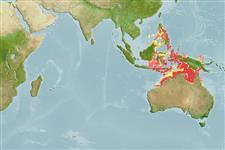>
Eupercaria/misc (Various families in series Eupercaria) >
Nemipteridae (Threadfin breams, Whiptail breams)
Etymology: Nemipterus: Greek, nema, -atos = filament + Greek, pteron = wing, fin (Ref. 45335).
More on author: Bleeker.
Environment: milieu / climate zone / depth range / distribution range
Ökologie
seewasser demersal; standorttreu; tiefenbereich 30 - 102 m (Ref. 9785). Tropical; 17°N - 19°S, 114°E - 147°E (Ref. 3810)
Western Central Pacific: Philippines, Indonesia, and northern Australia from the Timor Sea to northern Queensland. The name Nemipterus marginatus has been misapplied to this species by some authors.
Size / Gewicht / Alter
Maturity: Lm ? range ? - ? cm
Max length : 17.5 cm SL Männchen/unbestimmt; (Ref. 3810); common length : 15.0 cm SL Männchen/unbestimmt; (Ref. 3810)
Rückenflossenstacheln (insgesamt) : 10; Rückenflossenweichstrahlen (insgesamt) : 9; Afterflossenstacheln: 3; Afterflossenweichstrahlen: 7. Lower edge of eye touching or above a line drawn from the tip of snout to the upper base of the pectoral fin. Suborbital shallow, with a slightly emarginate lower edge. Dorsal fin origin about 2-6 scale rows from an imaginary line projected upwards from the posterior edge of the suborbital to dorsal profile. Relatively high soft dorsal fin, with the posterior rays the longest among the Nemipterus species. Upper lobe of caudal fin pointed and bright sulphur-yellow. Axillary scale present. Color: Pinkish head and body with mauve reflections, becoming pearly white on the ventral side.
Occurs on sand or mud bottoms. Appears in small numbers in local markets.
Life cycle and mating behavior
Geschlechtsreife | Fortpflanzung | Ablaichen | Eier | Fecundity | Larven
Russell, B.C., 1991. Description of a new species of Nemipterus (Pisces: Perciformes; Nemipteridae) from the Western Pacific, with re-descriptions of Nemipterus marginatus (Valenciennes), N. mesoprion (Bleeker) and N. nematopus (Bleeker). J. Nat. Hist. 25:1379-1389. (Ref. 3207)
IUCN Rote Liste Status (Ref. 130435: Version 2024-1)
Bedrohung für Menschen
Harmless
Nutzung durch Menschen
Fischereien: kleinfischerei
Tools
Zusatzinformationen
Download XML
Internet Quellen
Estimates based on models
Preferred temperature (Ref.
123201): 26.4 - 28.3, mean 27.4 °C (based on 146 cells).
Phylogenetic diversity index (Ref.
82804): PD
50 = 0.5000 [Uniqueness, from 0.5 = low to 2.0 = high].
Bayesian length-weight: a=0.02089 (0.01205 - 0.03623), b=2.96 (2.81 - 3.11), in cm total length, based on LWR estimates for this species & Genus-body shape (Ref.
93245).
Trophic level (Ref.
69278): 3.7 ±0.4 se; based on diet studies.
Widerstandsfähigkeit (Ref.
120179): hoch, Verdopplung der Population dauert weniger als 15 Monate. (Preliminary K or Fecundity.).
Fishing Vulnerability (Ref.
59153): Low vulnerability (11 of 100).
